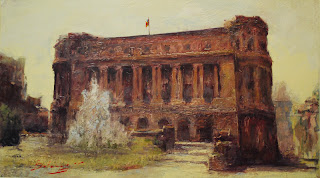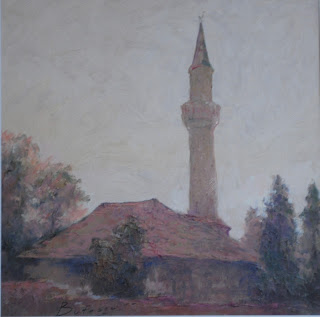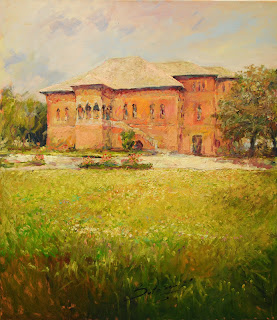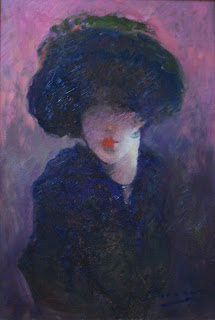Tell us about your beginnings in art…
I was born in Soviet Union, in small town of 17,000 inhabitants from Moldavia Republic, named Stefan Voda. When I was 10 years old, I had the chance to follow some art courses, extra school. In that time, some Russians specialized in art come to our town looking for talented children. They set up an Art School where I attend about 3 hours weekly for some years. These were my first professors and from them I learnt that I can make a living from art and because I love to paint, I decided I must continue on this way. "Italian Church"
"Stavropoleos Monastery"
You are graduated in Art Faculty from Cluj, Romania. How did you get in Romania? My town was 60 km far away from Odessa. Every studying child used to follow Odessa courses. My first art teachers advised me to follow a High School in Romanian language and not go Odessa, which is what I did. My style was full of colour different from the Russian School. After, I prepared myself for Art University from Saint Petersburg, but instead of this, I went Romania thank to 1989’s Romanian Revolution and some scholarships accorded by the Romanian State to Moldavians starting with 90’s. I chose Cluj city for my studies.
“Traditional house”
“Traditional house”
You stayed almost 10 years in London. How it was the English experience from artistic point ? In London I was not in the same line with the people from there because I just had to gain money for living. There was not time for carelessly artistic life. I had only to work to cover my expenses. So, it could not influence me too much. Anyway, I am too stubborn to be influenced. Since then, I only travel in Europe or other continents and I prefer to live in Romania.
"Spring"
"Mogosoaia Palace - winter"
Everything around me inspire me: from the smell of the morning coffee, to people from the street, friends, my workshop, until the evening spend with my family. From an artist 5% is talent, the rest is work and from a painting 20% is inspiration and the rest is reason, the theme.
“Military Circle”
"Manuc's Inn"
How do you choose your themes?
I don’t have a special criteria. It is about if I like it or not. For example the harlequins: I paint the first one when I was 16 years old as I wanted to gain more money and I succeeded. Since then I haven’t give up to this theme. The harlequins are characters who can transmit emotions. I prepare a big project with harlequins in the future.
“Harlequin”
“Harlequin”
Do you have favorite paintings?
I have a private collection with some of my peak works. I appreciate them even now. I have some nice works from 20 years ago. These paintings represent me from different periods and shows how I defined myself as a painter.
“View from Balcic”
“View from Balcic”
I like very much to paint, I can say that the painting is a hobby for me because I enjoy very much doing it. For example, I liked very much Balcic which was an good to be explored realm, so I painted over 200 paints with landscapes from Balcic.
“View from Balcic”
“Master of hearts”
“View from Balcic”
"Dusk with mosque"
"Houses from Balcic hill"
"Roofs at Balcic"
"Balcic"
Did the painter Bogdan Pietris influence you in any way ?
Yes, he was honest and sincere with me. I will always respect him. Even we had meet rare I consider him my friend. He is a lonely wolf as me. I learned from him plain-air.
“Cotroceni Palace”
“Mogosoaia Palace”
“Bridge from Cismigiu”
“Bear cart”
What do you transmit through your paintings?
A state of mind or a state of things. Spring time looks different from a winter time. Also, the same theme looks different if it is painted in the spring from the winter or afternoon from evening. The works painted in plain-air has a different energy and look from those painted in workshop. All these means state of things.
I like to paint in plain-air, but I use to finish my works in the workshop because the lights are different. After all, the public keeps the paintings in the house, so these must be done accordingly with the interior light.
“Still life”
“Waiting”
“Danube Delta “
An important thing is to know when to stop. If you keep on painting on the same paint, you can influence the light, the colour and it will not remain the same them, atmosphere or emotion. Many people tell me that my works are attractive, even if they are not classical. For example, a day light paint means cold colours, mine are warm.
“House form Bucharest"
“Prince Nicolae’s Villa”
Do you have any regret ?
I wish to be more beautiful. Beside this, I don’t have any regret.
“Portrait”
“Portrait”
“Portrait”
“Portrait”
Dr. Nour Foundation for Art and Heritage organized in 2010 a camp at Malta “Romanian Mona Lisa”. Vitalie Butescu was one of the artists selected to participate. You can admire what come out from this hands!
"Romanian Mona Lisa"
DNFAH collection
"Romanian Mona Lisa", version
DNFAH collection
"Church in Malta"
DNFAH collection
Personal Exhibitions
- 1997 september - "Art" Gallery, Timisoara
- 1997 december – The University Gallery University , Cluj Napoca
- 1998 december - Art Gallery, Timisoara
- 2005 february - Romanian National Committee pentru UNESCO
- 2005 may - FRACCU, Paris - France
- 2006 february –Romanian National Committee for UNESCO
- 2006 september - Gallery Silva Busteni
- 2006 nov.-dec. - City Gallery, Botosani
- 2007 february - ArtJazzClub Bucharest
- 2007 martch - Gallery Artis, Bucharest
- 2007 july - Gallery Artis, National Museum Olt, Slatina
- 2007 october - Ambasad SUA at Chisinau, Rep. Moldova
- 2008 august – exhibitional space ACVAL, Ploiesti
- 2008 october - Artis Gallery, National Museum Olt, Slatina
- 2008 december - Atelier Gallery Hanul cu Tei, Bucharest
- 2009 march - Ana Gallery, Bucharest
- 2009 march - Cultural Centre Habitus, Sibiu
- 2009 may-june - Elite Art Gallery, Bucharest
- 2009 september - Bucharest Mayorlaty
- 2009 oct-dec - Ceainaria Greentea, Bucuresti
- 2009 november - Artis Gallery, National Museum Olt, Slatina
- 2009 december – Romanian Atheneum
- 2010 february - Galateca, BCU Bucharest
- 2010 june – Art Museum Prahova "Ion Ionescu Quintus"
-2010 december – Brâncusi Hall, Parlament Palace
-2011 february - Art Gallery of Bucharest
-2011 march – Artis Gallery, National Museum Olt, Slatina
-2011 april - Hall Romanian Atheneum
-2011 september - SCITART Gallery Bucharest
-2011 december - U Art Gallery Bucharest
Works in private collections from Romania, Germany, Holland, Belgium, Hungary, Grece, Slovenia, Japan, Great Britain, USA, also in Contemporary Art Museums from Bucharest, Aiud, Medgidia, Constanta, Slatina.
N.B. Some of the works displayed above are for sale. If you want details about the painter and his paintings, please use email/telephone mentioned in Contact section.

















.jpg)



.jpg)
.jpg)
.jpg)


.jpg)





































